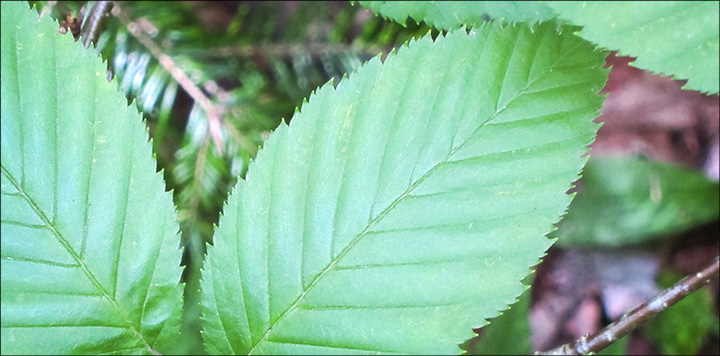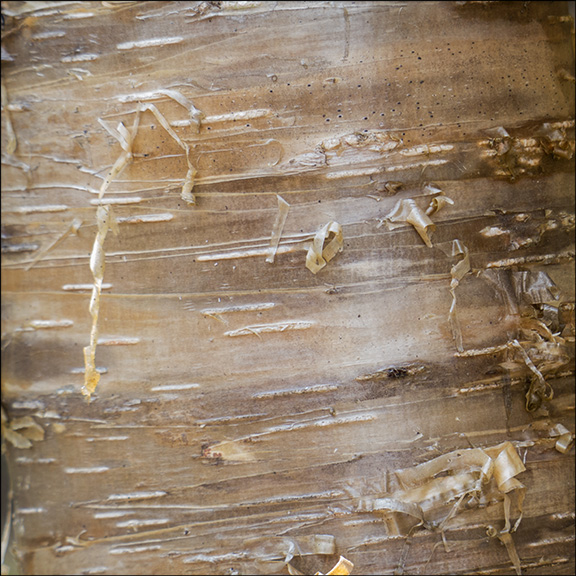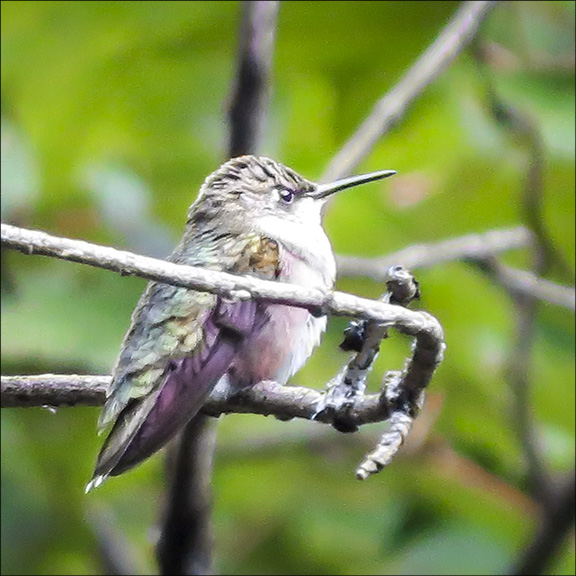Trees of the Adirondacks:
Yellow Birch (Betula alleghaniensis)
 Trees of the Adirondacks: The leaves of Yellow Birch have finely double-toothed edges. Yellow Birch on the Barnum Brook Trail (2 June 2012).
Trees of the Adirondacks: The leaves of Yellow Birch have finely double-toothed edges. Yellow Birch on the Barnum Brook Trail (2 June 2012).
| This page is no longer being updated. For an updated and expanded version of this material, see: Yellow Birch (Betula alleghaniensis) . |
The Yellow Birch (Betula alleghaniensis) – known for its distinctive, golden peeling bark – is a native, deciduous tree that grows throughout New York State and the Adirondack Mountains. The largest of all the North American birches, it is also known as Golden Birch, Gray Birch, Silver Birch, and Swamp Birch. The common name – Yellow Birch – refers to the color of the bark.
This tree is very long-lived for a birch, sometimes reaching beyond 100 years. This slow-growing tree may grow to 100 feet, although 50 feet is far more typical. Michael Kudish sampled tree ages in the Paul Smiths area and recorded a Yellow Birch on the Fish Pond Truck Trail that was 235 years old and 36 inches in diameter.

Identification of the Yellow Birch: Yellow Birch bark is bronze or yellowish-gray when the tree is young. The outer layers of the bark peel horizontally in thin, curly, papery strips. As the tree matures, the curls of peeling bark become more abundant and may appear shredded. Once the tree reaches about a foot in diameter, the bronze curls weather off, revealing a thick, platy outer bark, which is irregularly cracked. The inner bark has a wintergreen odor and taste, as do the twigs.
Yellow Birch leaves are elliptical, about 2.5 inches wide. The dark green leaves grow in an alternate arrangement, emerging from the stem one at a time. Yellow Birch leaves have a pointed tip and finely double-toothed edges. Young leaves are bronze-green, with long hairs beneath. In the fall, the leaves turn bright yellow.
The tree flowers in late May in the Adirondacks. Showy catkins appear just before leaf emergence. The male catkins are long, dropping and yellowish, appearing in cluster of five to eight. The female flowers are 5/8 to 3/4 inches long, upright catkins. The fruit, which matures in fall, is composed of numerous, tiny winged seeds packed between the catkin bracts.
The Yellow Birch tree's distinctive peeling bark is the main clue to distinguishing it from other deciduous trees in the Adirondacks. The main difficulty is differentiating Yellow Birch from Paper Birch.
- Both Paper Birch and Yellow Birch feature peeling bark. However, the Paper Birch has bright white bark, the underside of which is a pinkish color. When it peels, the strips are fairly wide, and thick. Yellow Birch bark, by contrast, is more bronze in color; and the bark of the Yellow Birch tends to peel off in thin papery ringlets. This distinction is less helpful in older specimens, when the bark has darkened with age.
- The leaves of Yellow Birch resemble those of the Paper Birch, but are longer and narrower.
- The scent of the stem is another identifier. Scrape a short section of the twig of the birch in question with your fingernail and give it a sniff. If it smells like wintergreen, you probably have a Yellow Birch. Sweet Birch twigs also give off a wintergreen scent, but they are uncommon in the Adirondacks.
Uses of the Yellow Birch: This tree is one of the most valuable northern hardwoods in Adirondack forests. The wood is heavy, strong, close- grained, and even-textured. It is used for furniture, flooring, cabinetry, charcoal, pulp, interior finish, veneer, tool handles, boxes, wooden-ware, and interior doors. The wood can be stained and takes a high polish. Yellow birch chips can be used to produce ethanol and other products.
Yellow Birch has a number of edible uses. Yellow Birch trees can be tapped for sap, which is used to make an edible syrup. The sap is harvested in early spring, before the leaves unfurl, by tapping the trunk. Although the sap flows abundantly, the sugar content is much lower than that of the Sugar Maple. The inner bark can be cooked or dried and ground into a powder and used with cereals in making bread. A tea can also made from the twigs and leaves. The wintergreen-flavored twigs and leaves of the Yellow Birch reportedly can be used as condiments.
Yellow birch is little used medicinally, although a decoction of the bark is said to have been used by native North American Indians as a blood purifier. The Delaware, for instance, used a decoction of the bark as a cathartic. The Iroquois reportedly used a decoction as a treatment for skin ailments.

Wildlife Value of the Yellow Birch: Yellow Birch trees are an important plant for animals. Yellow Birch saplings are a favorite browse of White-tailed Deer. Moose, Eastern Cottontail, and Snowshoe Hare also use the plant for food. Red Squirrels cut and store the mature catkins and eat the seeds. American Beaver and North American Porcupine chew the bark.
Yellow Birch trees also provide food and breeding habitat for a number of birds. The small, upright cones of the Yellow Birch disintegrate slowly and release their seeds as spring approaches, providing a vital food source for wetland birds at a time when many other food sources are scarce. Pileated Woodpeckers, Fox Sparrows, Black-capped Chickadees, Pine Siskin, Common Redpoll, and Ruffed Grouse are among the bird species which feed on Yellow Birch seeds.
In addition, the Yellow Birch is a common tree in the breeding habitat for several species of birds, including: Ruby-throated Hummingbirds, Mourning Warbler, Brown Creeper, and Northern Parula. Moreover, Ruby-throated Hummingbirds, Red-shouldered Hawks, and Boreal Chickadees sometimes nest in Yellow Birch trees. In the Adirondacks, Broad-winged Hawks show a clear preference for Yellow Birch as a nest site.
Range and Habitat of the Yellow Birch: The range of the Yellow Birch extends from Newfoundland to northern Minnesota, south through Wisconsin and Michigan to Pennsylvania, and in the Appalachian Mountains to northern Georgia. In New York State, the Yellow Birch is found in most of the eastern counties, including those in the Catskills and the Adirondack Mountains, as well as some counties in western New York.
Yellow Birch, which has wider shade and soil tolerances than Paper Birch, is most commonly found in moist woodland. In the Adirondacks, Yellow Birch trees are uncommon above 3000 feet, but are common on moist soil along stream banks, swamps, and slopes. Yellow Birch is typically a mixed-stand species; it is commonly found in association with other species rather than in pure stands. It is almost universally present in second-growth Adirondack forests. The seeds of the Yellow Birch germinate with difficulty on hardwood litter and thus do best on mossy logs, stumps, and boulders.
Yellow Birch at the Paul Smiths VIC: Look for Yellow Birch along many of the trails at the VIC, growing as individual trees in mixed stands, near Eastern Hemlock and Hobblebush. The most convenient place to observe the Yellow Birch and compare this tree with the Paper Birch and other deciduous trees at the VIC is on the Barnum Brook Trail. This species is one of the eleven tree species marked with signage along this trail. The identified Yellow Birch is about half-way around the loop. If you take the left hand fork of the trail near the gazebo and walk the trail in a clockwise direction, the tree is beyond the bridge over Barnum Brook, just past the Hobblebush on the left-hand side of the trail.
References
- United States Department of Agriculture. Forest Service. Silvics of North America. Yellow Birch. Retrieved 11 April 2016.
- United States Department of Agriculture. Forest Service. Fire Effects Information System (FEIS). Betula alleghaniensis. Retrieved 16 April 2016.
- United States Department of Agriculture. Plants Database. Retrieved 16 April 2016.
- United States Department of Agriculture. Natural Resources Conservation Service. Yellow Birch Plant Guide. Retrieved 16 April 2016.
- Lady Bird Johnson Wildflower Center. Native Plant Database. Retrieved 16 April 2016.
- University of Wisconsin. Trees of Wisconsin. Betula alleghaniensis. Retrieved 16 April 2016.
- Online Encyclopedia of Life. Betula alleghaniensis. Retrieved 16 April 2016.
- University of Wisconsin. Flora of Wisconsin. Retrieved 16 April 2016.
- New York Flora Association. New York Flora Atlas. Retrieved 16 April 2016.
- University of Michigan. Native American Ethnobotany. A Database of Foods, Drugs, Dyes and Fibers of Native American Peoples, Derived from Plants. Retrieved 19 April 2016.
- Plants for a Future. Database. Retrieved 19 April 2016.
- The Birds of North America. Subscription Web Site. Ruby-throated Hummingbird, Mourning Warbler, Brown Creeper, Pileated Woodpecker, American Redstart, Broad-winged Hawk, Boreal Chickadee, Fox Sparrow, Northern Parula, Retrieved 15 April 2016.
- Butterflies and Moths of North America. 16 April 2016.
- Paul F. Matray. "Broad-Winged Hawk Nesting and Ecology," The Auk. Vol. 91, No. 2 (Apr., 1974), pp. 307-324. Retrieved 16 April 2016.
- Ellen Rathbone, "Adirondack Tree Identification 102," The Adirondack Almanack, 18 November 2009. 16 April 2016.
- E.H. Ketchledge. Forests and Trees of the Adirondacks High Peaks Region (Lake George, New York: Adirondack Mountain Club, 1996), pp. 110-113.
- Michael Kudish. Adirondack Upland Flora. An Ecological Perspective (Saranac, New York: The Chauncy Press, 1992), pp. 122-123, 248.
- Michael Wojtech. Bark: A Field Guide to Trees of the Northeast (University Press of New England, 2011), pp. 106-107.
- William K. Chapman and Alan E. Bessette. Trees and Shrubs of the Adirondacks. A Field Guide (Utica, New York: North Country Books, Inc., 1990), p. 30, Plate 8.
- Stan Tekiela. Trees of New York. Field Guide. (Cambridge, Minnesota: Adventure Publications, Inc., 2006), pp. 76-77.
- Peter J. Marchand. Nature Guide to the Northern Forest. Exploring the Ecology of the Forests of New York, New Hampshire, Vermont, and Maine (Boston, Massachusetts: Appalachian Mountain Club Books, 2010), p. 85.
- George A. Petrides. A Field Guide to Eastern Trees (Boston: Houghton Mifflin Company, 1998), pp. 100-101, 317.
- George A. Petrides. A Field Guide to Trees and Shrubs (Boston: Houghton Mifflin Company, 1958,1972), pp. 233-234, 338-339.
- Gil Nelson, Christopher J. Earle, and Richard Spellenberg. Trees of Eastern North America (Princeton : Princeton University Press, 2014), pp. 152-153.
- C. Frank Brockman. Trees of North America (New York: St. Martin's Press), pp. 104-105.
- Keith Rushforth and Charles Hollis. Field Guide to the Trees of North America (Washington, D.C., National Geographic, 2006), p. 109.
- National Audubon Society. Field Guide to North American Trees. Eastern Region (New York: Alfred A. Knopf, 1980, 1995), Plates 180, 487, 617; pp. 364-365.
- Allen J. Coombes. Trees (New York: Dorling Kindersley, Inc., 1992), p. 119.
- Alexander C. Martin, Herbert S. Zim, and Arnold L. Nelson. American Wildlife & Plants: A Guide to Wildlife Food Habits (New York: Dover Publications, 1951), pp. 304-305.
- Bruce Kershner, et al. National Wildlife Federation Field Guide to Trees of North America (New York: Sterling Publishing Co., 2008), p. 407.
- John Eastman. The Book of Forest and Thicket. Trees, Shrubs, and Wildflowers of Eastern North America (Harrisburg, Pennsylvania, 1992), pp. 30-31.
- David Allen Sibley. The Sibley Guide to Trees (New York: Alfred A. Knopf, 2009), p. 156.
- Janet Lyons and Sandra Jordan. Walking the Wetlands. A Hiker's Guide to Common Plants and Animals of Marshes, Bogs, and Swamps (New York: John Wiley & Sons, 1989), pp. 107-108.
